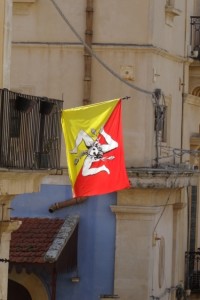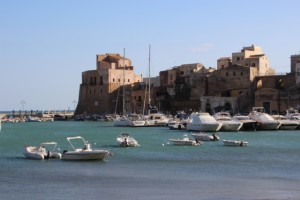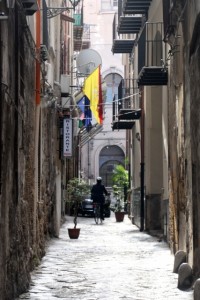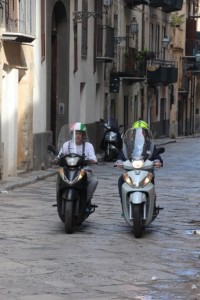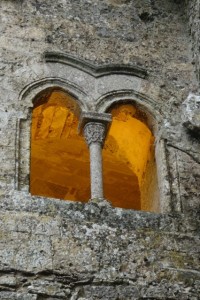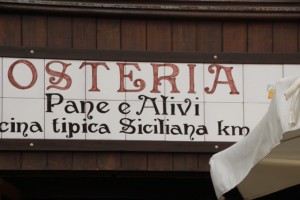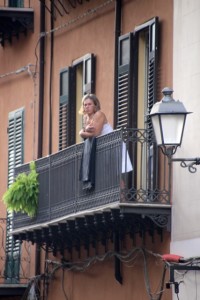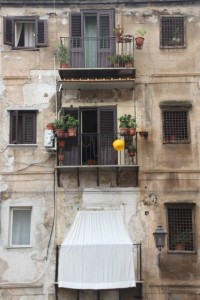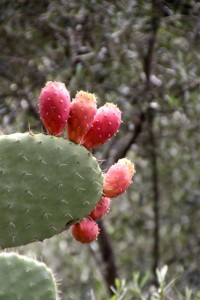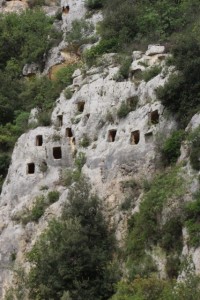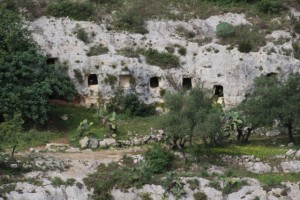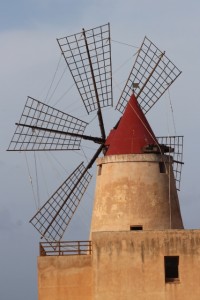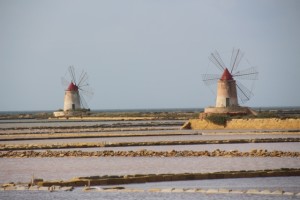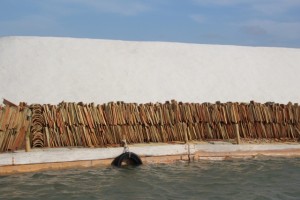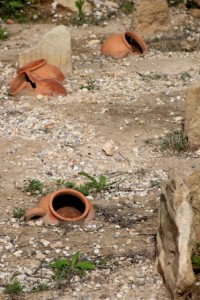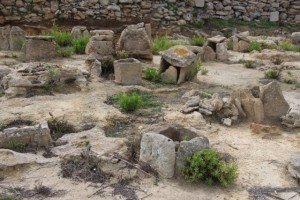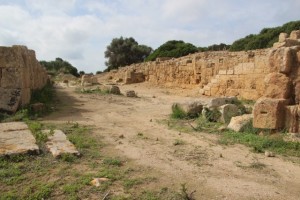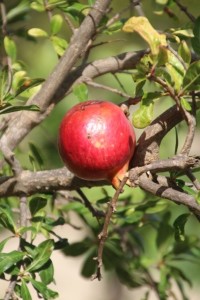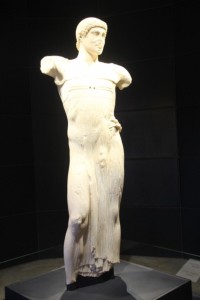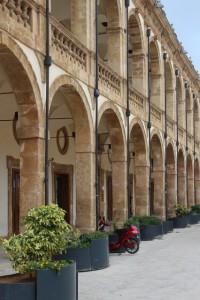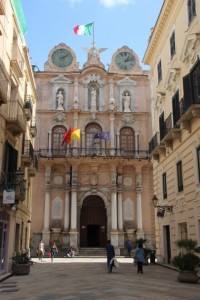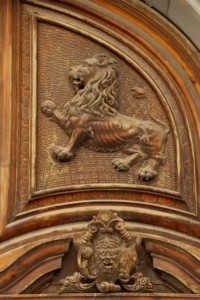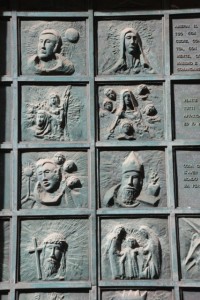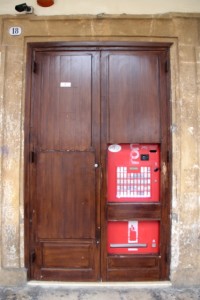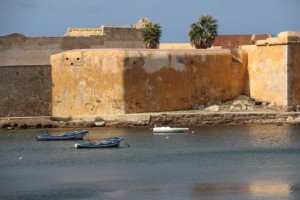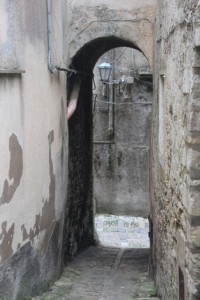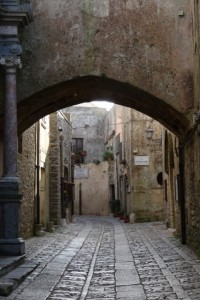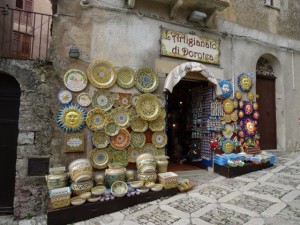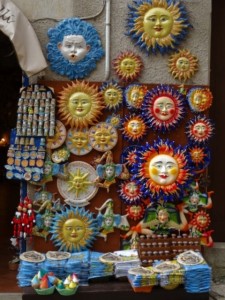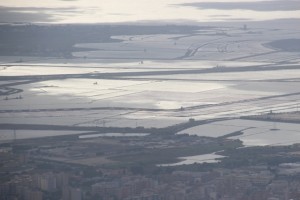Arriving at Palermo’s Falcone-Borsellino Airport – named after the two indefatigable Mafia fighters of the 1990’s, both killed by that same Mafia – we headed straight to the car rental agencies. Where we were pleasantly surprised to find that our booking for a small car had been upgraded, at no extra cost, to a medium sized one. Nice!
Half an hour later, in the heart of Castelmare del Golfo, our first destination, we were cursing the car rental company. You don’t want anything bigger than the smallest possible car in Sicily: inevitably, you’ll be caught up in city centres, or village centres for that matter, with impossibly narrow streets and sharp corners. Even the wider streets are a challenge: the Italian way of parking if the space is too small, is to go head first, leaving the tail somewhere on the main street. Or, more often, you park next to, instead of in front or behind the already parked cars, equally blocking a large part of the road. Bottom line is that negotiating a Sicilian town centre is quite a confrontation for those not used to it. The smaller the car, the easier. Which is what old hands know, which is why it easy to get an upgrade at the car rental agency, but near impossible to get a downgrade.
Castellammare del Golfo was our first base, on our ten day Sicily tour. Ten days is by far not enough to see everything there is to see in Sicily, the result of thousands of years of colonisation. Every Mediterranean culture has been here, from the Phoenicians and the Greeks, to – predictably – the Romans, followed by Arabs, who were subsequently thrown out by the Normans, who lost the island to the Spanish, after which Sicily was handed down from European power to European power, with nobody really wanting to have it. In the 19the Century the idea of a united Italy took hold, to which Sicily enthusiastically subscribed, only to find that not much had change, the aristocracy still dominated the island, their privileges largely maintained at the expense of the starving peasant population. Which is perhaps why there was quite a serious movement to link up as the 40th-something state of the US (really!!), after Sicily was liberated by the Americans in the latter days of WWII – a movement that came to nothing, not in the least because colonisation wasn’t that popular in the US anymore, at the time. So Sicily was stuck with Italy, once more, but with an ever diminishing influence of the aristocracy increasingly being replaced by family- and village-based criminal gangs, difficult to penetrate because of their code of silence – the omerta -, but even more so because of their intricate links with, literally, the highest levels of Italian politics. And this strangle-hold of the Mafia on ordinary Sicily has badly affected post-war development, which is why Sicily – and with it large parts of Southern Italy – is now the poorest area of an already relatively poor European country. And yet, for the occasional tourist it doesn’t show.
On the contrary, for the tourist Sicily is an incredibly rich island, rich in history – all those colonial powers have left their mark -, rich in architecture, rich in natural beauty, rich in food and drink, rich in incredibly friendly people – from the outside you, or at least I, don’t recognise the Mafioso!
Most of this story will touch on the architectural remains, of course, which are easiest illustrated. The earliest traces we came upon are the extensive Necropoli of Pantalica in the southeast. Thousands of rock graves, apparently dating back to the 12th to 8th Century BC, have been hewn in the steep walls along the valley of the Anapo River. The bones and bodies have long gone, and what is left is a honey comb of holes; in quite a few occasions one wonders how they were ever reached.
Our guidebook, possibly somewhat biased, claims that the best preserved remains of Phoenician settlements anywhere in the world are on the tiny island of Mozia. Well, so much for Phoenician remains, which are not much more than piles of rubble in which with a healthy dose of imagination the outline of houses may be recognised. The excursion to the island starts at the tiny landing spot among the Salini di Trapani, extensive salt flats that have somewhat diminished in importance since they hey days from the 12th Century, but still produce the best salt in Italy. Heaps of the stuff line the pools and the picturesque wind mills, used in the past to pump out excess water, proudly stand as testimony of a now largely bygone economic boom. A passenger ferry travels up and down to the small island, where one is free to wander from site to site, sometimes accompanied by relatively clear text boards explaining in English, too, what there is to see, but more often being confronted with a rotting plank on which, with difficulty, some Italian-only text can be deciphered. Mozia was acquired in its entirety by Joseph Whitaker, an Englishman whose family gained great wealth from developing the sweet Marsala wines in the nearby town of the same name in the beginning of the 20th Century – did I mention colonialism, earlier? His impressive archaeological collection is on display in his villa, now the museum, on the island. The museum alone is worth the trip, but a walk among the ruins, even if largely unrecognisable, is equally rewarding. I happen to have a fascination for burial grounds, and the one on Mozia – in this case quite recognisable as such – displays a great variety of urns, sarcophagi and other tomb structures.
East of Mozia is Marsala – indeed, where the sweet desert wines come from -, a charming town originally founded by the Phoenicians, but later conquered by the Arabs, who gave it its current name: Marsa Allah, or Port of God (think of that, next time you sip your glass of Marsala). A little further east is Mazaro del Vallo, equally charming, and noteworthy for its Casbah neighbourhood, a maze of narrow streets in the historic centre, more reminiscent of North Africa than of Italy – and indeed, now populated largely by Tunesian immigrants.
To the west is Trapani, mostly displaying examples of 18th Century Spanish Baroque. Streets in the historic centre are filled with impressive palaces on both sides, suggesting that present-day Sicilian poverty is not from all times, although it is unlikely that most Sicilians benefitted from this extraordinary flaunting of wealth. More interesting is the small town of Erice, a medieval walled city on top of a 750 meter high mountain a little further west. Very touristic, I cannot imagine anybody actually living there, in between the souvenir stalls, but nice enough with its castles and its cobbled streets, and its views over the salt flats of Trapani.
Next is on Greek temples in Sicily.
